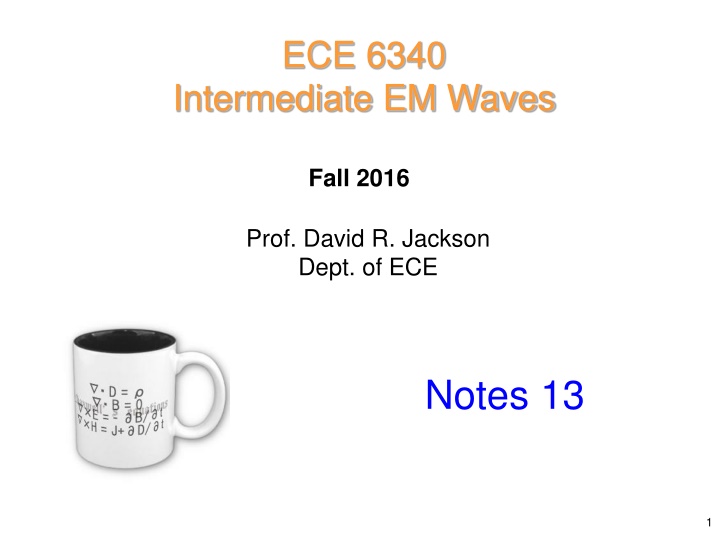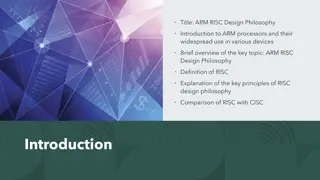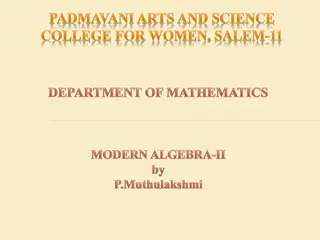
Orthogonality Theorems for Waveguides in Electromagnetic Theory
Explore the concept of mode orthogonality in electromagnetic waves, discussing the conditions for modes to be orthogonal, implications for power flow, and considerations for degenerate modes in waveguides. Discover how different modes interact and influence power distribution in waveguide structures.
Uploaded on | 0 Views
Download Presentation

Please find below an Image/Link to download the presentation.
The content on the website is provided AS IS for your information and personal use only. It may not be sold, licensed, or shared on other websites without obtaining consent from the author. If you encounter any issues during the download, it is possible that the publisher has removed the file from their server.
You are allowed to download the files provided on this website for personal or commercial use, subject to the condition that they are used lawfully. All files are the property of their respective owners.
The content on the website is provided AS IS for your information and personal use only. It may not be sold, licensed, or shared on other websites without obtaining consent from the author.
E N D
Presentation Transcript
ECE 6340 Intermediate EM Waves Fall 2016 Prof. David R. Jackson Dept. of ECE Notes 13 1
Mode Orthogonality z Mode m (Em, Hm) Mode n (En, Hn) c C Waveguide modes are orthogonal (in the complex power sense) if: * n = z dS ( ) 0 E H m S 2
Mode Orthogonality (cont.) Assume two modes are orthogonal, and examine the complex power flowing down the guide when two modes are present: 1 2 * = E H z dS ( ) P z S 1 2 1 2 * m * n = + ) ( + z dS ( ) E E H H m n S 1 2 * m * n = + z dS z dS ( ) ( ) E H E H m n S S 1 2 1 2 * n * m + + z dS z dS ( ) ( ) E H E H m n S S 3
Mode Orthogonality (cont.) Hence = + ( ) m ( ) n P P P z z z If two modes are orthogonal, the total complex power is the sum of the two complex powers of the individual modes. 4
Reference To see a derivation of the orthogonality theorems presented here, and others, please see the following reference: R. E. Collin, Field Theory of Guided Waves, IEEE Press, 1991. 5
Waveguides with PEC Walls (There may be a lossy material inside the waveguide.) Theorem 1 A TEzmode is always orthogonal to a TMzmode. Theorem 2 Two TMz modes (or two TEzmodes) are orthogonal to each other if they are not degenerate: k k zm zn 6
Degenerate Modes Degenerate modes are not in general orthogonal. A simple example is two modes that are really the same mode. TE10 mode + = 1 Watt 1 Watt 4 Watt If the mode doubles, the fields are twice as strong, and hence the power increases by a factor of four. 7
Degenerate Mode (cont.) Sometimes the modes are orthogonal, even when they are degenerate. Square waveguide: TE10 and TE01 modes These two modes are orthogonal (even though they are degenerate). 8
Degenerate Mode (cont.) If two modes of the same type are degenerate, but they are linearly independent, we can always choose a combination of them that will correspond to two orthogonal modes. Circular waveguide: Two TE11 modes Not orthogonal Orthogonal 9
Rectangular Waveguide For a rectangular waveguide, two modes of the same type (TEz or TMz) will be orthogonal provided that the mode indices are not exactly the same. ( ) ( 1 1 , m n ) , m n 2 2 TEmn TMmn b or a The proof is left as a homework problem. (Use orthogonality of the sin and cosine functions that make up the field variations in the x and y directions.) 10
Orthogonality Between Incident and Reflected Waves Assume a single mode, but waves going in both directions: 1 2 * = E H z dS ( ) P z S 1 2 1 2 + + = + ) ( + * z dS ( ) E E H H t t t t S 1 2 + + * * = + z dS z dS ( ) ( ) E H E H t t t t S S 1 2 1 2 + + * * + + z dS z dS ( ) ( ) E H E H t t t t S S 11
Orthogonality Between Incident and Reflected Waves (cont.) The real part of the complex power (watts) is + = + Re Re Re P P P z z z 1 2 1 2 + + * * + + z dS z dS Re ( ) Re ( ) E H E H t t t t S S Examine the following term: * 1 TE + + * = z E E H E (assume TEz) t t t t Z ( ) 1 TE + * = z E E t t * Z 12
Orthogonality Between Incident and Reflected Waves (cont.) We then have ( ) 1 TE + + * * = z E E H E t t t t * Z ( ) 1 TE + * = z E E ( ) ( ) ( ) B C = A B A C C A B Note: t t * Z Similarly, we have ( ) 1 TE + + * * = + z E E H E t t t t * Z ( ) 1 TE + * = + z E E t t * Z 13
Orthogonality Between Incident and Reflected Waves (cont.) We then have + = + Re Re Re P P P z z z 1 2 1 TE 1 2 1 TE + + * * + + + Re Re E E dS E E dS t t t t * * Z Z S S = real TE Z If the waveguide is lossless and we are above cutoff : + = + Re Re Re P P P z z z ( ) ( ) 1 TE 1 * + + * * Re2 E E E E dS t t t t Z S 14
Orthogonality Between Incident and Reflected Waves (cont.) or + = + Re Re Re P P P z z z ( ) 1 TE 1 2 + * Re 2 Im j E E dS t t Z S or + = + Re Re Re P P P z z z The total power (watts) in a lossless waveguide is the sum of the two individual powers. Note: For a lossless waveguide above cutoff, the powers will all be real (so we don t actually need to take the real part). 15
Orthogonality Between Incident and Reflected Waves (cont.) For a lossless waveguide with a reflected wave, we can then say: ( ) 2 = inc z 1 P P z inc zP +z z -z 2 inc zP 16
Appendix Here we mention some other types of orthogonality relations that exist for waveguides: Orthogonality for waveguides with lossy walls Orthogonality for the longitudinal fields Orthogonality for the transverse electric or magnetic fields 17
Waveguides with Lossy Walls The previous two theorems (theorem 1 and theorem 2) hold for a waveguide with lossy walls if we change the definition of orthogonality to be: (The lossy walls are modeled as an impedance surface.) = z dS ( ) 0 E H m n S (Note that there is no conjugate here.) However, in this case, we can no longer say that the total power flowing down the waveguide is the sum of the individual mode powers. 18
Orthogonality for Longitudinal Fields Consider two non-degenerate modes that are either both TMz or both TEz. Then we have that dS = ( ) m z ( ) n z ( ) 0 E E k k TMz zm zn S dS = ( ) m z ( ) n z k k ( ) 0 H H TEz zm zn S Assumption: lossless walls Note: If the two modes are degenerate, but they are linearly independent, we can always choose a combination of them that will correspond to two orthogonal modes. 19
Orthogonality for Transverse Fields Consider two non-degenerate modes that are either both TEz or both TMz. Then we have that for either case, ( ) m t ( ) n t = ( ) 0 E E dS k k zm zn S ( ) m t ( ) n t = k k ( ) 0 H H dS zm zn S Assumption: lossless walls Note: If the two modes are degenerate, but they are linearly independent, we can always choose a combination of them that will correspond to two orthogonal modes. 20
Orthogonality for Transverse Fields (cont.) Consider one mode that is TEz and one mode that is TMz. Then we have that TM t TE t = ( ) 0 E E dS S TM t TE t = ( ) 0 H H dS S Assumption: lossless walls This orthogonality is true whether the modes are degenerate or not. 21






















